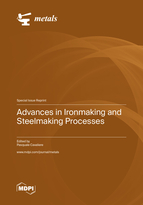Advances in Ironmaking and Steelmaking Processes
A special issue of Metals (ISSN 2075-4701). This special issue belongs to the section "Extractive Metallurgy".
Deadline for manuscript submissions: closed (31 March 2023) | Viewed by 36298
Special Issue Editor
Interests: thermal spray coatings; powder metallurgy; severe plastic deformation; ironmaking and steelmaking
Special Issues, Collections and Topics in MDPI journals
Special Issue Information
Dear Colleagues,
Ironmaking and steelmaking involve various processes and technologies that can be operated and organized in different combinations depending on the changing material properties and final required products. Different raw materials, energy requirements, and investments can vary as a function of the different plant configurations and the chosen advanced technologies employed for emissions reductions. In the industrial and scientific fields, it is critical to have a clear idea of the most recent technological innovations for the reduction of hazardous emissions from ironmaking and steelmaking plants with good levels of productivity. Due to the low level of restrictions and international protocols active during the last 15–20 years, innovation has been growing so fast that knowledge of the best available technologies is fundamental for scientists and industrial operators.
Indications from the steel industry are that the breakthrough technologies for decarbonization will be based on hydrogen reduction. Given that the two main routes for primary steel production decarbonization will almost certainly be CCS and hydrogen-based reduction, public and private R&D spending as well as investment in pilot plants should focus on driving down their cost and increasing the efficiency of electrolysis equipment, piloting and driving down the cost of hydrogen-based reduction.
For CO2-lean process routes, three major ways of solutions have been identified: decarbonizing, whereby coal would be replaced by hydrogen or electricity in hydrogen reduction or electrolysis of iron ore processes; CCS technology introduction; and the use of sustainable biomass.
Through a hydrogen-based steelmaking route, CO2 emissions would be reduced by more than 80%. Hydrogen steelmaking will depend profoundly on the availability of green hydrogen. It can be generated from natural gas by steam reforming, or from water by electrolysis. Today hydrogen-based steelmaking is a potential low carbon and economically attractive route, especially in those countries where natural gas is cheap. In considering systems for increasing the energy efficiency and reducing the environmental impact of steel production, CO2 emissions may be greatly reduced by hydrogen-based steel production if the hydrogen is generated by means of carbon-free and renewable sources. Currently, the development of hydrogen economy has received a great deal of attention in that H2 is considered a promising alternative to replace fossil fuels. If H2 is utilized as an alternative fuel, not only can the problem of progressively exhausted fossil fuel reserve be solved but the atmospheric greenhouse effect can also be mitigated. The “hydrogen economy”, based on hydrogen, is a promising clean energy carrier for decarbonized energy systems if produced from renewable energy sources or coupled with carbon capture and storage (CCS) or nuclear energy.
This Special Issue aims to focus on those traditional or innovative routes capable of reducing energy consumption and harmful greenhouse emissions. Obviously, discussions of energy will take into account the direct and indirect energy consumption for each analyzed technology. The methods to improve energy efficiency are energy consumption optimization, online monitoring, and energy audits.
The Special Issue will describe the main approaches to produce and synthesize iron and steel through hydrogen-based technologies. The best available techniques and futuristic solutions will be described according to the processing route and energy demand. For this Special Issue, we welcome contributions from both universities and industries toward evaluating the industrial feasibility of each selected technology. Our goal is to describe the most efficient solutions being applied by ironmaking and steelmaking factories all around the world.
The potential contributions will include the following main issues:
-Traditional ironmaking and steel making route
-Direct reduction of iron ores
-Hydrogen ironmaking
Prof. Dr. Pasquale Cavaliere
Guest Editor
Manuscript Submission Information
Manuscripts should be submitted online at www.mdpi.com by registering and logging in to this website. Once you are registered, click here to go to the submission form. Manuscripts can be submitted until the deadline. All submissions that pass pre-check are peer-reviewed. Accepted papers will be published continuously in the journal (as soon as accepted) and will be listed together on the special issue website. Research articles, review articles as well as short communications are invited. For planned papers, a title and short abstract (about 100 words) can be sent to the Editorial Office for announcement on this website.
Submitted manuscripts should not have been published previously, nor be under consideration for publication elsewhere (except conference proceedings papers). All manuscripts are thoroughly refereed through a single-blind peer-review process. A guide for authors and other relevant information for submission of manuscripts is available on the Instructions for Authors page. Metals is an international peer-reviewed open access monthly journal published by MDPI.
Please visit the Instructions for Authors page before submitting a manuscript. The Article Processing Charge (APC) for publication in this open access journal is 2600 CHF (Swiss Francs). Submitted papers should be well formatted and use good English. Authors may use MDPI's English editing service prior to publication or during author revisions.
Keywords
- ironmaking
- steelmaking
- greenhouse gases
- energy
- direct reduction
- carbon capture
- electrolysis






